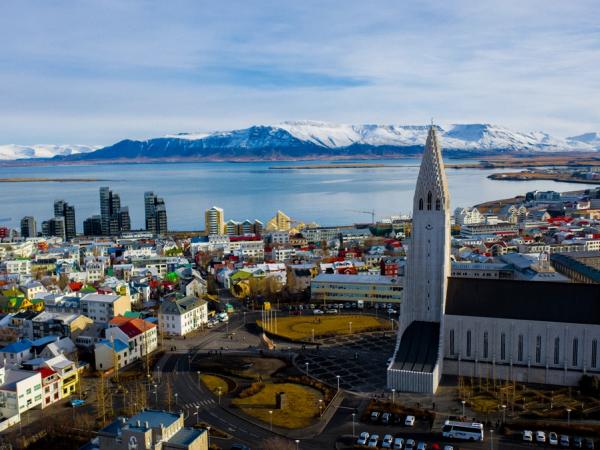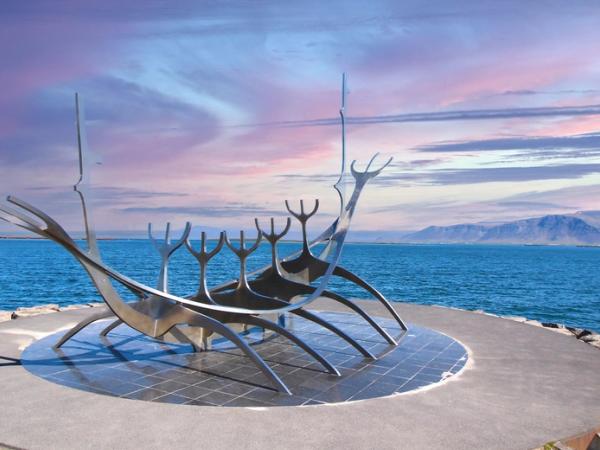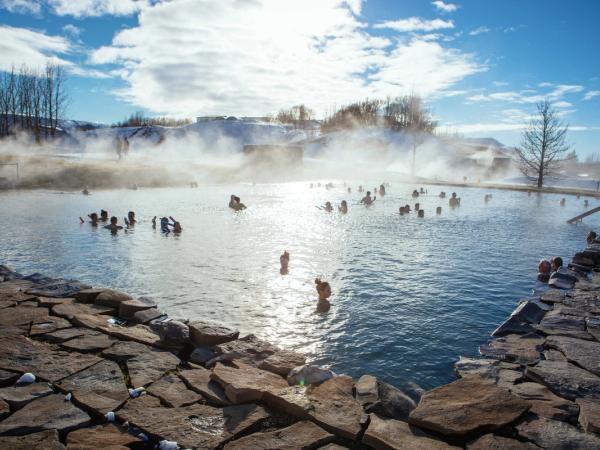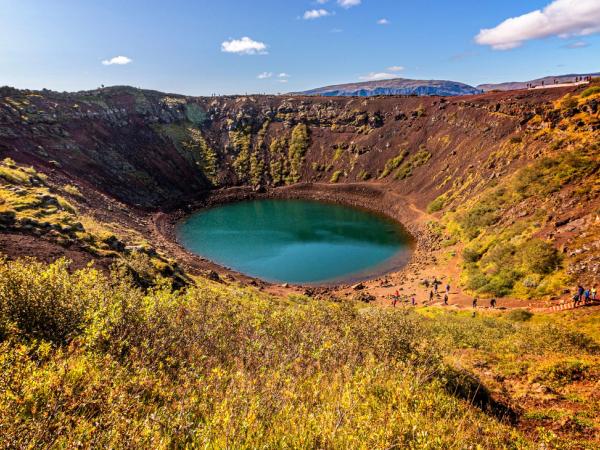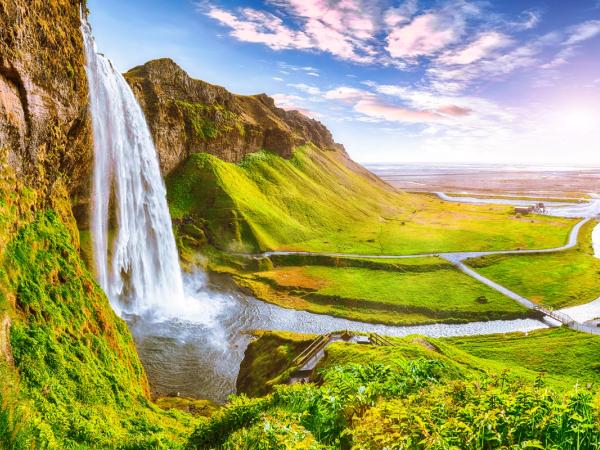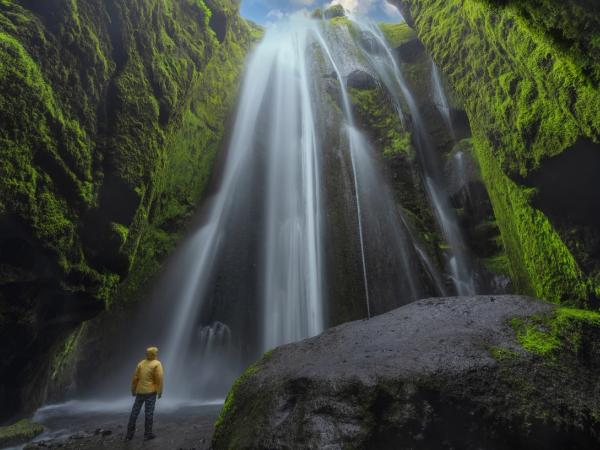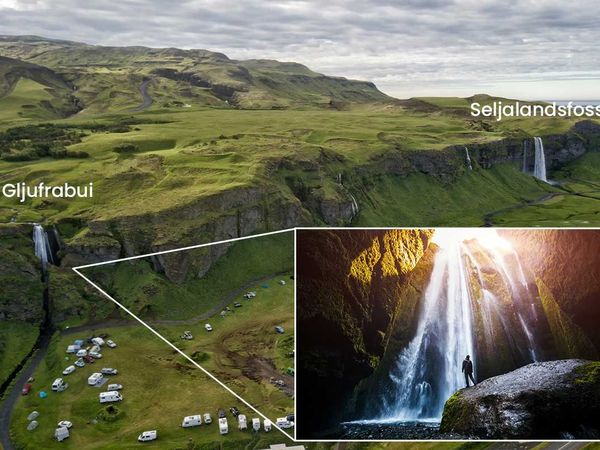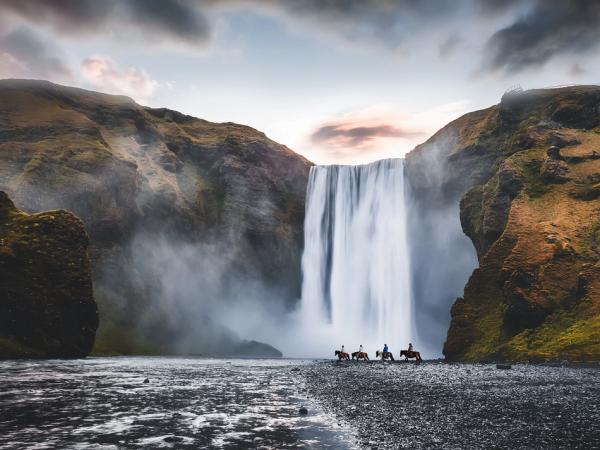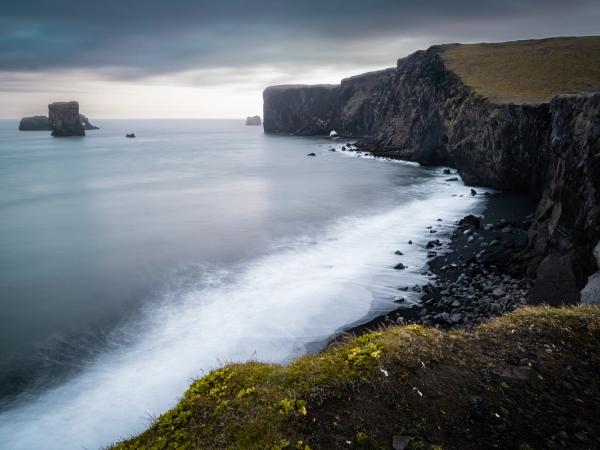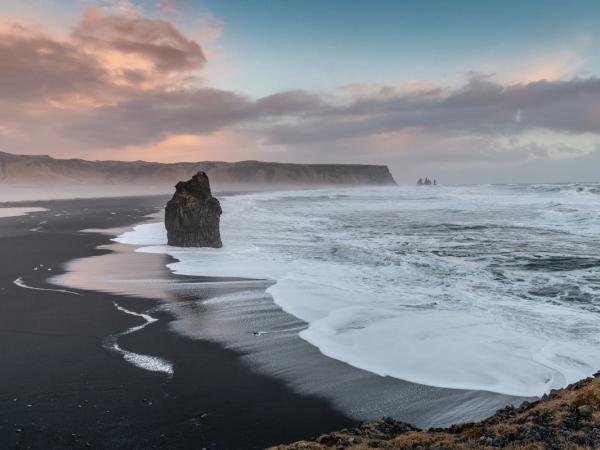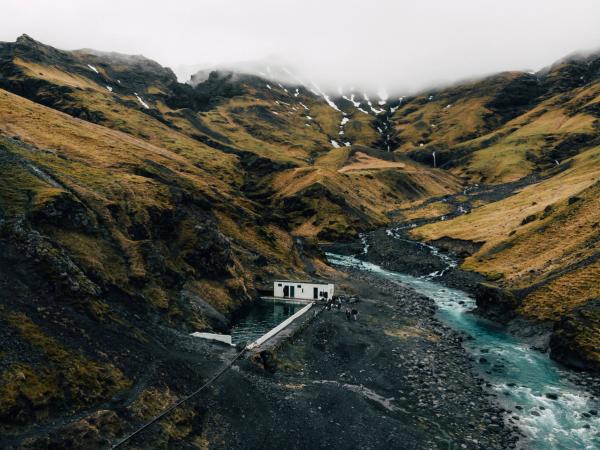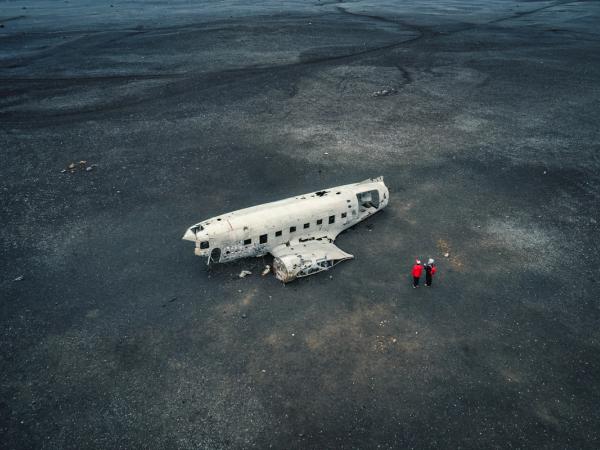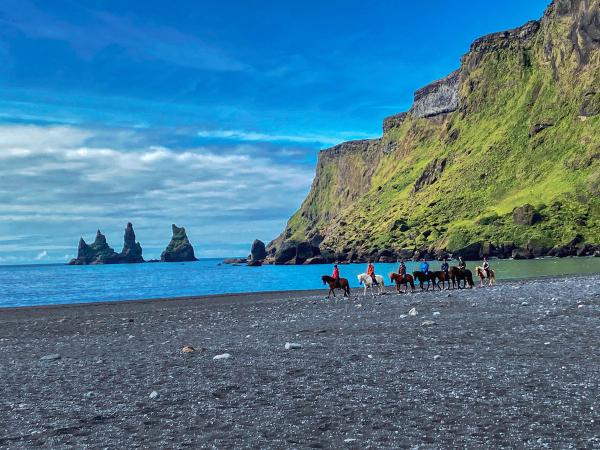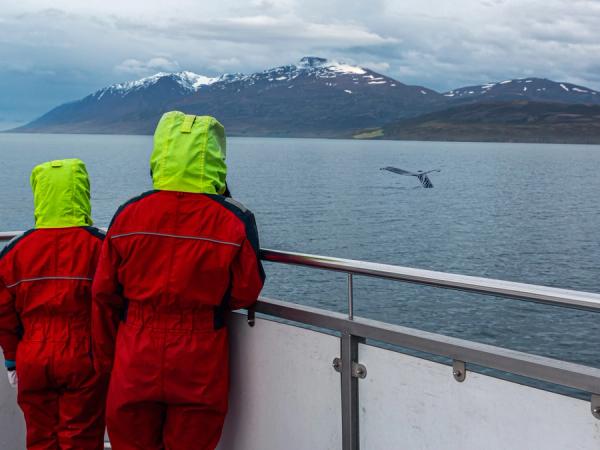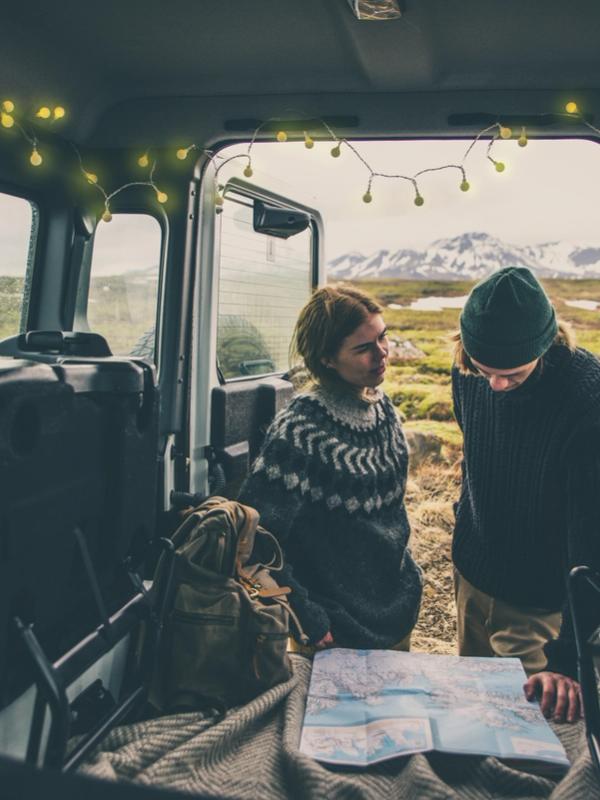
3 Days in Iceland: Your Perfect Short Break Itinerary
Three days might sound short, but Iceland squeezes a surprising amount into a small corner of the map. Within a couple of hours of Reykjavik, you can stand between shifting tectonic plates, feel geysers rumble under your feet, and hike behind waterfalls that roar so loud you can barely hear yourself think. In the capital itself, colorful streets, world-class museums, and a thriving food scene set the tone for your trip.
This 3-day Iceland itinerary blends it all: a taste of Reykjavik, the iconic Golden Circle, and the dramatic South Coast. With a rental car or well-planned tours, you’ll experience some of the country’s most unforgettable sights in a short timeframe.
Is 3 Days Really Enough to Visit Iceland?
Yes – if you plan smartly. Three days in Iceland won’t cover everything, but it’s plenty of time to see the highlights without feeling rushed. Reykjavik makes the perfect base, and driving distances are manageable. Renting a car gives you the most flexibility, but guided tours are a good alternative if you’d rather skip the driving.
Day 1: Arrival and Reykjavik Highlights
Spending a bit of time in Reykjavik is the best way to start your 3-day Iceland adventure. The city's compact size makes it easy to walk around and take in its cultural landmarks, beautiful architecture, and authentic Icelandic charm. A lot of people also choose to first stop at the Blue Lagoon before heading into town – a great choice for those looking to spend time soaking in Iceland’s geothermal waters. The Sky Lagoon in Kópavogur, right next to Reykjavik, is another popular choice.
Breakfast to fuel your day
Sandholt bakery in the town center is a great spot to kick off your Reykjavik adventure. This local favorite serves fresh-baked goods, breakfast sandwiches, waffles, and egg dishes. Their pastries will give you all the energy you need to explore everything on your 3-day Iceland itinerary. Elsewhere, the cinnamon scrolls at Brauð & Co are now coveted across the city.
Hallgrímskirkja and the Sun Voyager
Hallgrímskirkja is Reykjavik's most iconic landmark, sitting atop a hill and towering over the city. The 73-meter tower is Iceland’s tallest building and a landmark you can spot from almost anywhere in the city. Guðjón Samúelsson designed it in 1937, inspired by the basalt lava columns that shape much of Iceland's landscape.
The observation tower is worth the small fee for the amazing 360° views of the city's colorful rooftops, Faxaflói Bay, and mountain ranges from central Reykjavik's highest point. At least, if it’s not a foggy day.
The waterfront's gleaming Sun Voyager sculpture sits just a short walk away down on the water’s edge. While it looks like a Viking ship, artist Jón Gunnar Arnason created this steel masterpiece as a "dream boat" that symbolizes hope, progress, and freedom. Mount Esja creates a stunning backdrop that photographers love.
Explore Reykjavik's museums and Perlan
Perlan is worth carving out time for. Sitting on top of Öskjuhlíð hill, this domed museum mixes hands-on exhibits with sweeping city views (it’s even ranked among the world’s top 1% of attractions on Tripadvisor for several years running). The museum has some incredible exhibits:
- A 100-meter-long ice cave built with 350 tons of snow
- The Forces of Nature exhibit about Iceland's volcanic systems
- A Northern Lights planetarium show
- A 360° observation deck with clear views across Reykjavik
Other top museums to consider include the National Museum, the Settlement Exhibition, the Lava Show, or even Flyover Iceland for a bird’s-eye view of the country’s landscapes.
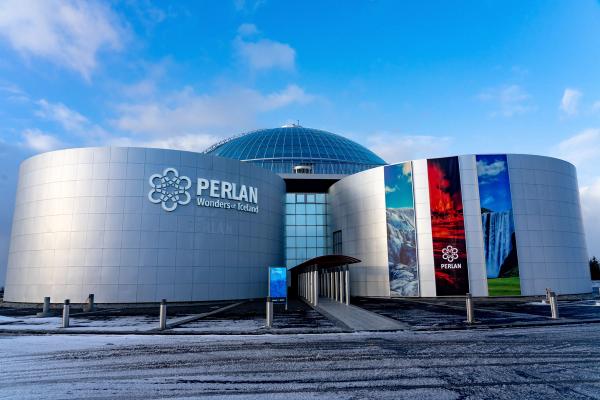
The Old Harbor and Harpa Concert Hall
The Old Harbor is a charming area for a short walk, wandering past fishing boats and whale-watching ships at anchor. It eventually leads you to the stunning and modern Harpa Concert Hall. This award-winning building opened in 2011 and catches everyone's eye with its three-dimensional glass panels that dance with daylight. You can enter inside free of charge, and enjoy views over the bay towards the mountains from the common areas (you won’t be able to enter the concert halls themselves)
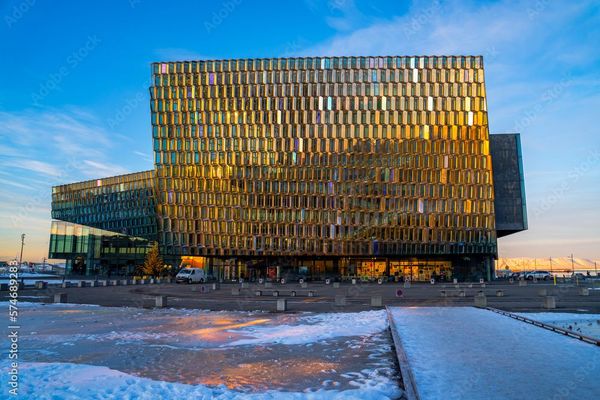
Optional: Reykjavik walking tour or Phallological Museum
To take in all of these sights alongside some local knowledge, a Reykjavik City Walking Tour might be your best bet. They usually last about 2–2.5 hours and cover not just the city’s major sights, but also loads of history and culture. Many guides let you pay what you think is fair, which makes these tours a great deal.
And yes, there is a museum dedicated entirely to the male penis. The Icelandic Phallological Museum near the harbor is another interesting choice for a day in Reykjavik. The museum shows almost 300 specimens from nearly all Icelandic land and sea mammals. It might sound strange, but they present everything scientifically, and there's even a themed bistro.
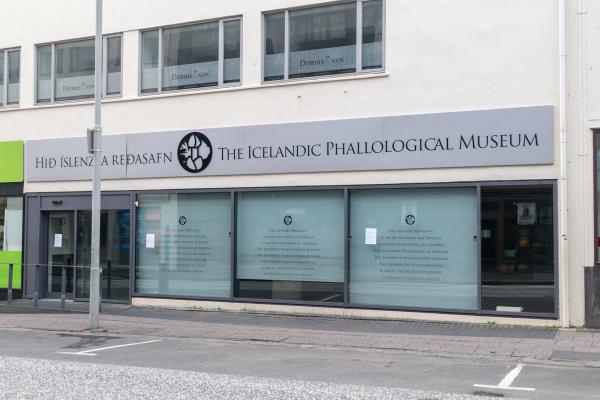
Day 2: Golden Circle Adventure
The Golden Circle is Iceland's most iconic day trip, and an easy choice for any 3-day trip in Iceland. This 300-kilometer loop strings together some of Iceland’s best-known sights – waterfalls, geysers, and raw volcanic landscapes – all close enough to cover in a single day, getting back to the city in time for dinner.
Þingvellir National Park
Most Golden Circle trips begin at Þingvellir National Park, the historic heart of Iceland, just 45 minutes from the capital. Here, the Mid-Atlantic Ridge rises above sea level, you can admire a beautiful lake surrounded by lava fields and mountains, and even walk the rift between the North American and Eurasian tectonic plates.
The park is a UNESCO World Heritage Site and the birthplace of Icelandic democracy; this is where the first settlers gathered to pass laws, trade, and settle disputes for hundreds of years. The plates still drift apart by about 2 centimeters each year, slowly reshaping the landscape you see today.
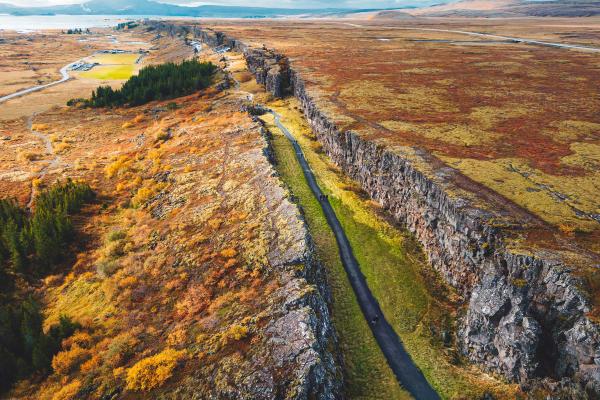
Geysir Geothermal Area
About 60 km (37 miles) from Þingvellir, the earth comes alive in the Geysir Geothermal Area. The Great Geysir itself rarely erupts now, but Strokkur has stepped up instead, sending columns of scalding water 15–20 meters high every 5–10 minutes, sometimes hitting 40.
Around the main geyser, bubbling mud pots and smaller hot springs dot the valley, while the ground itself glows with yellow sulfur, green copper, and rusty-red iron. Steam rises in shifting clouds that you can spot from the road long before you arrive.
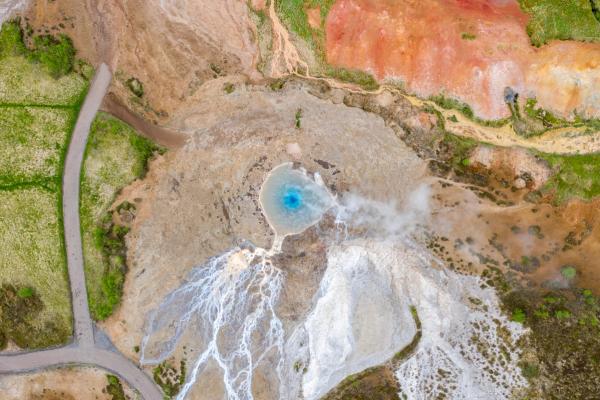
Gullfoss Waterfall
Just 10 minutes from Geysir, Gullfoss thunders into a deep glacial canyon in two dramatic tiers – first a 11-meter (36-foot) drop, then a sheer 21-meter (69-foot) plunge. In summer, the Hvítá River surges with up to 140 cubic meters of water every second, throwing rainbows into the mist on sunny days. Winter freezes the edges into sculpted ice, transforming it into a different kind of spectacle. Two main paths offer different perspectives; in summer, the lower route brings you close enough to feel the spray, though winter ice often keeps that trail closed.
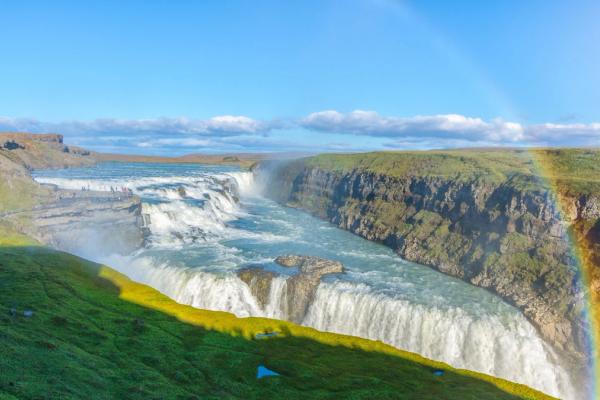
Optional: Secret Lagoon or Keri Crater
A couple of easy detours can add something extra to your Golden Circle loop. The Secret Lagoon (Gamla Laugin) in Flúðir is Iceland’s oldest swimming pool, first built in 1891. Its naturally heated waters hover around 38–40°C (100–104°F) year-round, making it a relaxing way to wind down after a day on the road.
Kerið Crater is another quick stop worth making. This 6,500-year-old volcanic caldera glows with vivid red and orange slopes wrapped around a striking blue lake. At 270 meters long and 55 meters deep, it’s one of the most photogenic spots on the route – and an easy way to mix in a little color between waterfalls and hot springs.
Day 3: South Coast Wonders
The South Coast is where Iceland cranks up the drama. Volcanoes, glaciers, and the Atlantic have been fighting over this stretch of land for centuries, leaving behind some of the country’s most unforgettable scenery.
Seljalandsfoss and Gljúfrabúi Waterfalls
Seljalandsfoss is one of Iceland’s most famous falls for good reason – you can walk behind its 60-meter curtain of water for a completely different perspective. The cascade flows from the Eyjafjallajökull glacier, dropping into a deep green bowl. Just a short walk away, Gljúfrabúi hides inside a narrow cleft in the cliff. To see it, you’ll need to squeeze through the gap and wade into what feels like a secret cavern. Bring waterproof pants and boots – you’ll get wet here.
Skogafoss and Kvernufoss Waterfalls
A half-hour east of Seljalandsfoss, Skógafoss roars over a 60-meter cliff in a perfect rectangular sheet of white water. On sunny days, rainbows arc through the spray – it’s one of the most beautiful and popular waterfalls in Iceland, and worthy of the hype.
For something quieter, hike 20 minutes east to Kvernufoss, a lesser-known waterfall tucked into a narrow gorge. The trail starts behind the Skógasafn museum and follows the river into a hidden valley. In summer, you can walk behind Kvernufoss, just like Seljalandsfoss, and feel the cold spray hit your skin.
Dyrhólaey Peninsula and Reynisfjara Black Sand Beach
Dyrhólaey Peninsula is the southernmost point of Iceland’s mainland, a huge cliff where puffins wheel in the wind, and you can see for miles in all directions. The views of the black sand stretching into the horizon are especially striking.
Reynisfjara is the South Coast’s most famous stop: a wide stretch of jet-black sand framed by basalt cliffs and sea stacks rising offshore. The beach was born from cooling lava meeting the Atlantic, with the ocean grinding it into smooth black grains. The cave at Halsanefshellir and the geometric basalt columns are highlights, but so is the power of the sea itself. Sneaker waves here are notorious, so keep a safe distance from the surf.
Optional: Seljavallalaug Hot Spring or Sólheimasandur plane wreck
To pack out your day on the South Coast, detour into the hills below the glacier Eyjafjallajökull to find Seljavallalaug, one of Iceland’s oldest pools, built in 1923. The simple concrete basin sits in a quiet valley, with water that stays around 20–30°C – not quite a hot spring, but an atmospheric soak.
Another option is the Sólheimasandur plane wreck, the ghostly remains of a 1973 US Navy DC-3 crash on the black sands. It’s a flat 6.5 km (4-mile) walk round trip, or you can catch a shuttle if you’re short on time.
Optional Add-Ons for Any Day
Iceland packs amazing add-on experiences that fit any day of your short itinerary. These activities add extra dimensions to your adventure and create lasting memories during your 3 days in Iceland.
Blue Lagoon or Sky Lagoon visit
Iceland’s two most famous geothermal spas offer different atmospheres but the same warm, mineral-rich soak. The Blue Lagoon’s milky waters are loaded with silica and algae, giving it its iconic color and skin-soothing qualities. Packages include a drink and face mask, and the larger pools mean there’s space to spread out.
The Sky Lagoon, closer to Reykjavík, trades that otherworldly color for an infinity-edge pool overlooking the ocean. Its seven-step ritual includes a sauna, steam room, and body scrub, and the 12+ age limit keeps things calm and spa-like.
Both hot springs stay open late in the summer, meaning you can even visit them after you’ve had your dinner.
Northern Lights tour (winter only)
The Aurora Borealis is a must-see experience on your Iceland travel itinerary. Tours leave Reykjavík between August and April and take you away from city lights to get the best views. Small groups make the experience more personal, and tour operators give out free hot chocolate and blankets to keep you cozy during the wait.
Since nature doesn't guarantee a show, many companies let you rebook free for another night if you don't see the lights on your first try.

Horseback riding or whale watching
Icelandic horses are famous for their unique tölt gait and hardy nature, making them perfect for short riding tours through lava fields or along black sand beaches. Trips range from one-hour rides to half-day adventures.
Whale watching is another classic add-on, with Reykjavík tours regularly spotting minke and humpback whales, dolphins, and porpoises. North Iceland boasts even higher success rates, along with the occasional orca sighting in spring. Tours typically last 2.5–3.5 hours and stay close to shore.
Travel Tips and Logistics
A well-planned logistics strategy can maximize your short stay in Iceland. Here are some practical tips to help direct your three-day adventure.
How to get around: car rental vs. tours
You'll have complete freedom to explore Iceland at your own pace with a self-driving option. This works great for photography stops and discovering hidden locations. Guided tours take care of all logistics and provide expert commentary plus winter driving safety. Car rentals are often 30–100% cheaper than booking multiple guided tours, making them a budget-friendly option. Solo adventurers might find bus tours more economical since they eliminate parking hassles.
Where to stay in Reykjavik
Downtown Reykjavik (also known as 101, its zip code) serves as the perfect base, putting you within walking distance of major attractions, restaurants, and shops. A double room with breakfast in a 3-4* hotel typically costs between 200-400 USD per night during summer.
If you choose to stay over in the countryside, there are also plenty of options along the Golden Circle and South Coast, making it easy to create the ideal 3-day Iceland itinerary.
Best time to visit: Summer vs. Winter
Summer months (June-August) bring mild temperatures of 10–13°C, occasionally climbing above 20°C. The nearly 24-hour daylight allows extended exploration time, meaning you can stay out as late as you like and make the most of your time.
A 3-day Iceland trip in winter is a little bit more limited, with about 4–5 hours of daylight in the middle of winter. Expect around -2°C, though the wind can make it feel much colder. That said, Iceland in winter has its own unique beauty, and of course, it’s your best chance to see the Northern Lights dancing in the skies above – a bucket list item for many travelers.
Packing essentials for 3 days in Iceland
- Year-round essentials: Waterproof jacket, sturdy hiking boots with good grip, waterproof pants, layers of clothing, swimsuit, camera gear
- Winter additions: Thermal underwear, warm gloves, ice cleats for shoes
- Summer additions: Sunglasses, sunscreen, insect repellent (especially for Lake Mývatn)
Note that Iceland's tap water is excellent—a reusable water bottle works better than buying bottled water.
Is A Short Trip to Iceland Worth It?
Absolutely. In just 3 days, you can explore Reykjavik’s cultural heart, stand between tectonic plates at Þingvellir, watch geysers erupt, and walk along black sand beaches. This itinerary shows how much of Iceland’s character you can experience in a long weekend without feeling rushed.
Whether you rent a car and create your own adventure or join guided tours, these 72 hours are the perfect introduction to the Land of Fire and Ice. Many travelers start planning their return trip before they even leave.



